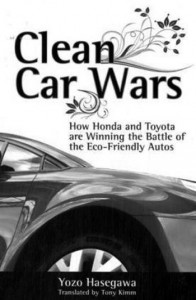The current United States presidential administration has put particular emphasis on protecting the environment and reversing the impact of global climate change in order to create a green economy. The Environmental Protection Agency (EPA) may see a ten percent increase in its budget for the next fiscal year due to the administration’s move toward action on these fronts. Today, the threats of global climate change and fossil fuel depletion are growing increasingly salient, and the need to reduce carbon dioxide emissions and to promote energy efficiency is becoming a more pressing issue than ever before.
With today’s environmental concerns, it is understandable or even expected that low-emission, fuel-efficient vehicles are becoming an increasingly important facet of the automotive industry. In Clean Car Wars: How Honda and Toyota are Winning the Battle of the Eco-Friendly Autos (2008), Yozo Hasegawa provides a compelling overview of the current landscape of the automotive industry and how that landscape came to be. Mounting environmental concerns have pushed car companies toward independence from oil, and the companies that have embraced this trend—namely, the Japanese Honda and Toyota motor companies—are the ones that have come out on top.
Hasegawa delves into the history of the environmentally friendly car, beginning with the development of the technology used in Toyota’s first hybrid car, the Toyota Prius. By starting at the beginning of these so-called clean car wars, the book supplies a thorough, step-by-step tour of how Toyota and Honda set the low-emission car standard early with their hybrid technologies. As a business journalist with a focus on the automotive industry, Hasegawa offers detailed information about these companies’ green technology initiatives from both engineering and managerial perspectives in order to explain how the companies arrived to where they are now.
Hasegawa’s discussion of technologies and management philosophies that have helped put leading Japanese car manufacturers ahead of the environmental technology curve serves as the scaffolding for his description of today’s automotive market on a worldwide scale. The book offers a look at where each major automotive maker currently stands in this clean car competition, describing who the leaders and followers are as well as which makers are the best positioned to survive and thrive in a twenty-first century automotive market. Toyota and Honda are placed in the lead, with European makers making up lost ground with rapidly advancing green diesel technologies, and American manufacturers playing catch-up.
In Clean Car Wars, Hasegawa argues that the automotive maker that can prove its ability to lead in eco-friendly designs and green technology will also be one of the industry’s leading contenders overall. Namely, the companies that will be able to build the best low-emission car will have the highest chance at long-term success. Almost all possible trajectories for the automotive industry lead away from fossil fuels, and manufacturers must accept this course early on.
Their survival—and, in part, the survival of the planet itself— depends upon it.
Book Information:
Clean Car Wars: How Honda and Toyota are
Winning the Battle of Eco-Friendly Autos
By Yozo Hasegawa, Translated by Tony Kimm
Wiley, 2008, 200 pp. ISBN: 0470823291
particular emphasis on protecting the environment and reversing
the impact of global climate change in order to create a green
economy. The Environmental Protection Agency (EPA) may see
a ten percent increase in its budget for the next fiscal year due to
the administration’s move toward action on these fronts. Today,
the threats of global climate change and fossil fuel depletion are
growing increasingly salient, and the need to reduce carbon dioxide
emissions and to promote energy efficiency is becoming a more
pressing issue than ever before.
With today’s environmental concerns, it is understandable or
even expected that low-emission, fuel-efficient vehicles are becoming
an increasingly important facet of the automotive industry. In
Clean Car Wars: How Honda and Toyota are Winning the Battle of the
Eco-Friendly Autos (2008), Yozo Hasegawa provides a compelling
overview of the current landscape of the automotive industry
and how that landscape came to be. Mounting environmental
concerns have pushed car companies toward independence from
oil, and the companies that have embraced this trend—namely,
the Japanese Honda and Toyota motor companies—are the ones
that have come out on top.
Hasegawa delves into the history of the environmentally
friendly car, beginning with the development of the technology
used in Toyota’s first hybrid car, the Toyota Prius. By starting at
the beginning of these so-called clean car wars, the book supplies
a thorough, step-by-step tour of how Toyota and Honda set the
low-emission car standard early with their hybrid technologies.
As a business journalist with a focus on the automotive industry,
Hasegawa offers detailed information about these companies’
green technology initiatives from both engineering and managerial
perspectives in order to explain how the companies arrived to
where they are now.
Hasegawa’s discussion of technologies and management philosophies
that have helped put leading Japanese car manufacturers
ahead of the environmental technology curve serves as the
scaffolding for his description of today’s automotive market on
a worldwide scale. The book offers a look at where each major
automotive maker currently stands in this clean car competition,
describing who the leaders and followers are as well as which
makers are the best positioned to survive and thrive in a twenty-first
century automotive market. Toyota and Honda are placed in the
lead, with European makers making up lost ground with rapidly
advancing green diesel technologies, and American manufacturers
playing catch-up.
In Clean Car Wars, Hasegawa argues that the automotive maker
that can prove its ability to lead in eco-friendly designs and green
technology will also be one of the industry’s leading contenders
overall. Namely, the companies that will be able to build the best
low-emission car will have the highest chance at long-term success.
Almost all possible trajectories for the automotive industry
lead away from fossil fuels, and manufacturers must accept this
course early on.
Their survival—and, in part, the survival of the planet itself—
depends upon it.

